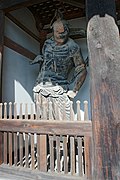| Part of a series on |
| Japanese Buddhism |
|---|
 |
This is the glossary of Japanese Buddhism , including major terms the casual (or brand-new) reader might find useful in understanding articles on the subject. Words followed by an asterisk (*) are illustrated by an image in one of the photo galleries. Within definitions, words set in boldface are defined elsewhere in the glossary.













































































